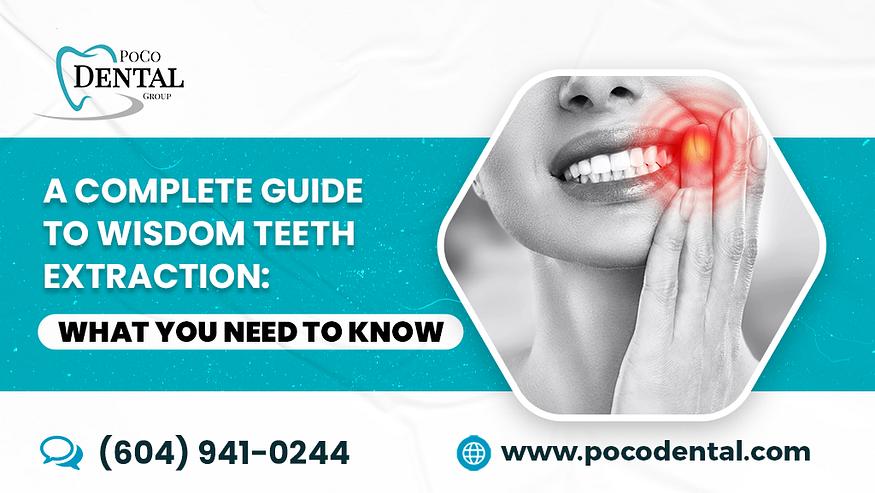A Complete Guide to Wisdom
Teeth Extraction: What You Need to Know
Feeling that all-too-familiar discomfort in your mouth? The kind that disrupts your focus, makes eating a challenge, and even hampers your ability to smile? No need to worry; you’re not alone. Wisdom teeth issues are a common rite of passage for many adults. But fear not! In this comprehensive guide to wisdom teeth extraction, we’ve got you covered with everything you need to know about this dental procedure, from recognizing the signs and symptoms to post-extraction care tips.
Understanding Wisdom Teeth
Most individuals have four wisdom teeth, also known as the third molars, located at the back of their mouth. These teeth typically emerge between the ages of 17 and 25. Impacted wisdom teeth can lead to pain, infections, and damage to neighboring teeth. If you’re considering wisdom teeth

removal, it’s crucial to prioritize oral care and adhere to your dentist’s guidance.
Why Wisdom Teeth Removal is Necessary
There are various reasons why people may need to have their wisdom teeth removed. For some, these teeth can grow in at an awkward angle, exerting pressure on adjacent teeth, resulting in pain or bite alignment issues. Moreover, wisdom teeth that only partially emerge or remain completely submerged can trap food and bacteria beneath the gum line, increasing the risk of tooth decay and infection.
The Wisdom Teeth Extraction Procedure
Wisdom teeth extraction is a routine procedure typically performed by oral surgeons. The surgery is often carried out under local anesthesia, numbing the area surrounding the wisdom teeth. During the procedure, the surgeon makes an incision in the gum tissue to access and remove the wisdom teeth.
Recovery Timeline Post-Wisdom Tooth Extraction
Your recovery following wisdom teeth removal depends on several factors, such as the number of wisdom teeth removed, the type of anesthesia administered, and your pain tolerance and healing capacity. Most people are back to their regular routines within a day or two. However, it’s vital to take it easy in the initial days, avoiding strenuous activities and hard-tochew foods to facilitate proper healing.
After the surgery, you may experience facial and jaw swelling, along with some bruising. This is a normal part of the healing process and typically resolves within about a week. To alleviate swelling, apply ice packs to your face for 20-minute intervals several times a day during the initial days. Over-the-counter pain medication can be used as needed for discomfort management.
While most individuals can return to work a few days after wisdom teeth removal, those with physically demanding jobs or significant pain may need more recovery time. Listening to your body is essential to ensure a speedy and successful recovery.
Managing Pain After Wisdom Tooth Extraction
Here are some key points to remember when managing pain after wisdom tooth extraction:
1. Over-the-counter pain relievers are often necessary for discomfort.
2. In cases of severe pain, your dentist may prescribe stronger pain medication.
3. Ice packs applied to the outside of your cheeks for 20-minute intervals several times a day can reduce swelling and pain.
4. Rest during the initial 24 hours post-surgery, avoiding strenuous activities, and staying hydrated by drinking plenty of fluids.
Diet and Nutrition Post-Wisdom Tooth Extraction
Maintaining a soft food diet and practicing good oral hygiene are crucial after wisdom teeth removal to aid healing and prevent infection.
Here are some dietary guidelines to follow:
- Steer clear of hard, crunchy, or chewy foods for at least a week. This includes items like popcorn, chips, nuts, pretzels, raw vegetables, and tough meats.
- Avoid for soft foods such as mashed potatoes, soup, yogurt, applesauce, ice cream, and pudding.
- Gradually reintroduce other foods into your diet as comfort allows.
- Avoid using a straw for at least a week, as the suction can disrupt the blood clot in the extraction site, potentially leading to a dry socket.
- Rinse your mouth with salt water (mix 1/2 teaspoon of salt in 8 ounces of water) several times a day to cleanse the area and promote healing.
Alternatives to Wisdom Tooth Extraction
Depending on the specific circumstances, there are alternatives to wisdom tooth extraction. One option is orthodontic exposure and bonding, a procedure that involves using braces or other devices to bring the wisdom tooth into its proper position. Another option is alveolar decortication,
which entails surgically removing a portion of the bone around the wisdom tooth to create space for it.
In Conclusion
Wisdom teeth extraction is a manageable procedure when approached with the right information and preparation. We hope this guide has provided you with a clear understanding of wisdom teeth removal, including its necessity, the procedure itself, potential risks, and how to care for yourself afterward. Should you have any questions or concerns about wisdom teeth removal, don’t hesitate to reach out to PoCo Dental Group, your trusted dentist in Coquitlam.
At PoCo Dental Group, we recognize the significance of maintaining optimal oral health. We take a personalized approach to ensure a comfortable and stress-free experience when it comes to wisdom tooth extraction. Our skilled and experienced dentists carefully assess each patient’s unique situation to determine the best course of action.
You can trust us to handle your wisdom tooth extraction with the utmost care and professionalism, leaving you with a healthier and happier smile. Contact us today to schedule a consultation and witness the positive impact our expertise and dedication can make.
